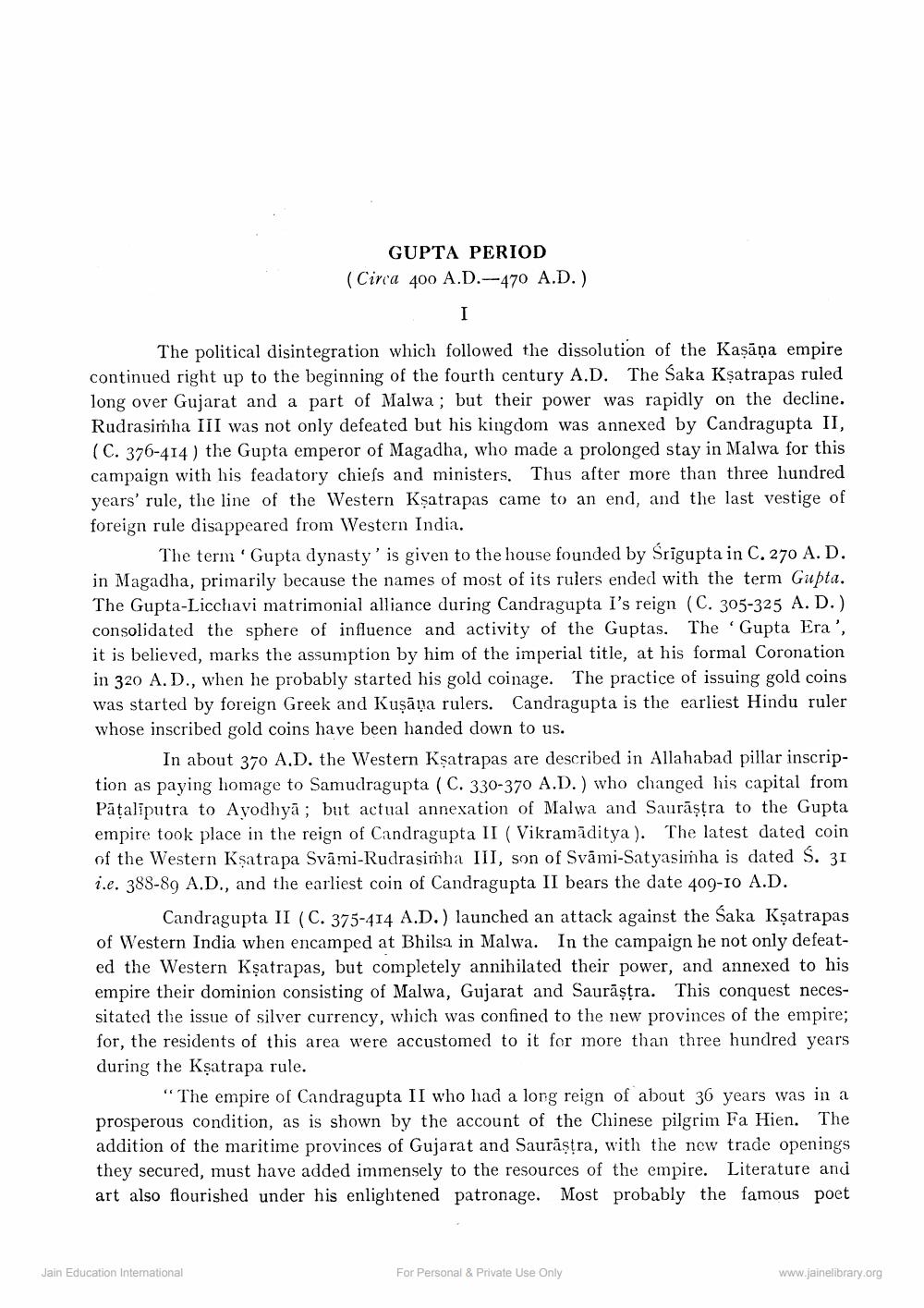________________
GUPTA PERIOD (Circa 400 A.D.-470 A.D.)
The political disintegration which followed the dissolution of the Kaşāņa empire continued right up to the beginning of the fourth century A.D. The Saka Kşatrapas ruled long over Gujarat and a part of Malwa ; but their power was rapidly on the decline. Rudrasimha III was not only defeated but his kingdom was annexed by Candragupta II, (C. 376-414 ) the Gupta emperor of Magadha, who made a prolonged stay in Malwa for this campaign with his feadatory chiefs and ministers. Thus after more than three hundred years' rule, the line of the Western Kşatrapas came to an end, and the last vestige of foreign rule disappeared from Western India.
The term 'Gupta dynasty' is given to the house founded by Srigupta in C. 270 A. D. in Magadha, primarily because the names of most of its rulers ended with the term Gupta. The Gupta-Licchavi matrimonial alliance during Candragupta I's reign (C. 305-325 A. D.) consolidated the sphere of influence and activity of the Guptas. The Gupta Era', it is believed, marks the assumption by him of the imperial title, at his formal Coronation in 320 A.D., when he probably started his gold coinage. The practice of issuing gold coins was started by foreign Greek and Kuşāņa rulers. Candragupta is the earliest Hindu ruler whose inscribed gold coins have been handed down to us.
In about 370 A.D. the Western Ksatrapas are described in Allahabad pillar inscription as paying homage to Samudragupta (C. 330-370 A.D.) who changed his capital from Pāțalīputra to Ayodhyā; but actual annexation of Malwa and Saurāşțra to the Gupta empire took place in the reign of Candragupta II ( Vikramāditya ). The latest dated coin of the Western Kșatrapa Svāmi-Rudrasimha III, son of Svāmi-Satyasimha is dated $. 31 i.e. 388-89 A.D., and the earliest coin of Candragupta II bears the date 409-10 A.D.
Candragupta II (C. 375-414 A.D.) launched an attack against the Saka Kșatrapas of Western India when encamped at Bhilsa in Malwa. In the campaign he not only defeated the Western Kşatrapas, but completely annihilated their power, and annexed to his empire their dominion consisting of Malwa, Gujarat and Saurāştra. This conquest necessitated the issue of silver currency, which was confined to the new provinces of the empire; for, the residents of this area were accustomed to it for more than three hundred years during the Kșatrapa rule.
"The empire of Candragupta II who had a long reign of about 36 years was in a prosperous condition, as is shown by the account of the Chinese pilgrim Fa Hien. The addition of the maritime provinces of Gujarat and Saurāştra, with the new trade openings they secured, must have added immensely to the resources of the empire. Literature and art also flourished under his enlightened patronage. Most probably the famous poet
Jain Education International
For Personal & Private Use Only
www.jainelibrary.org




